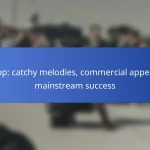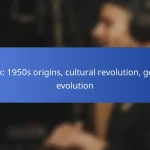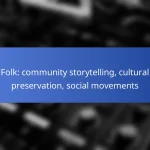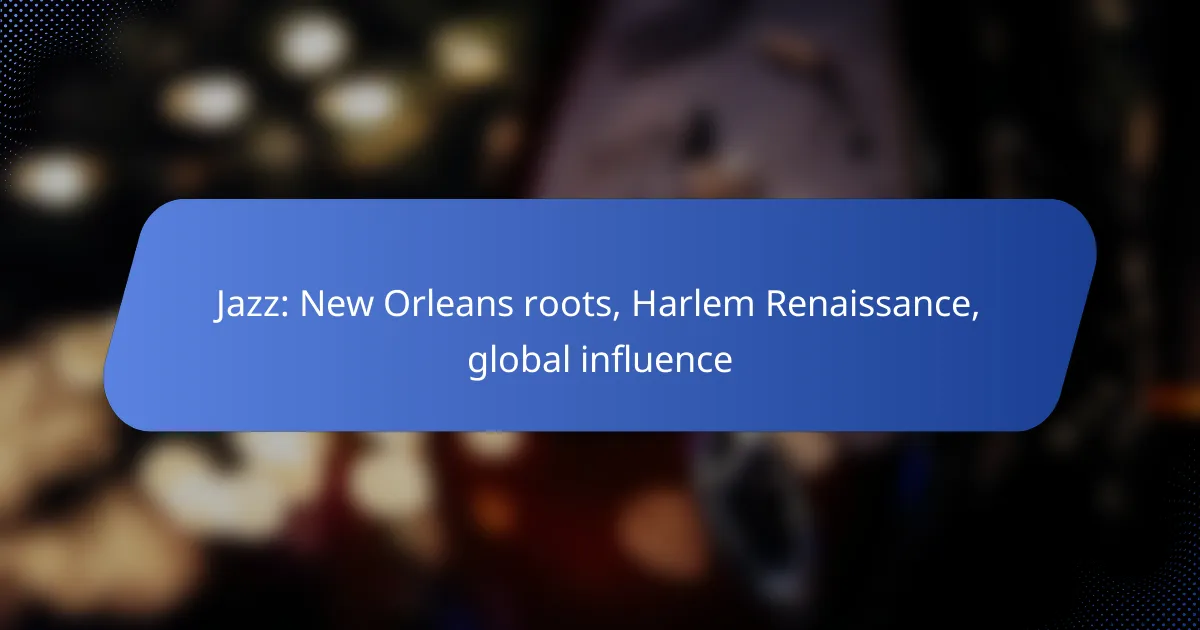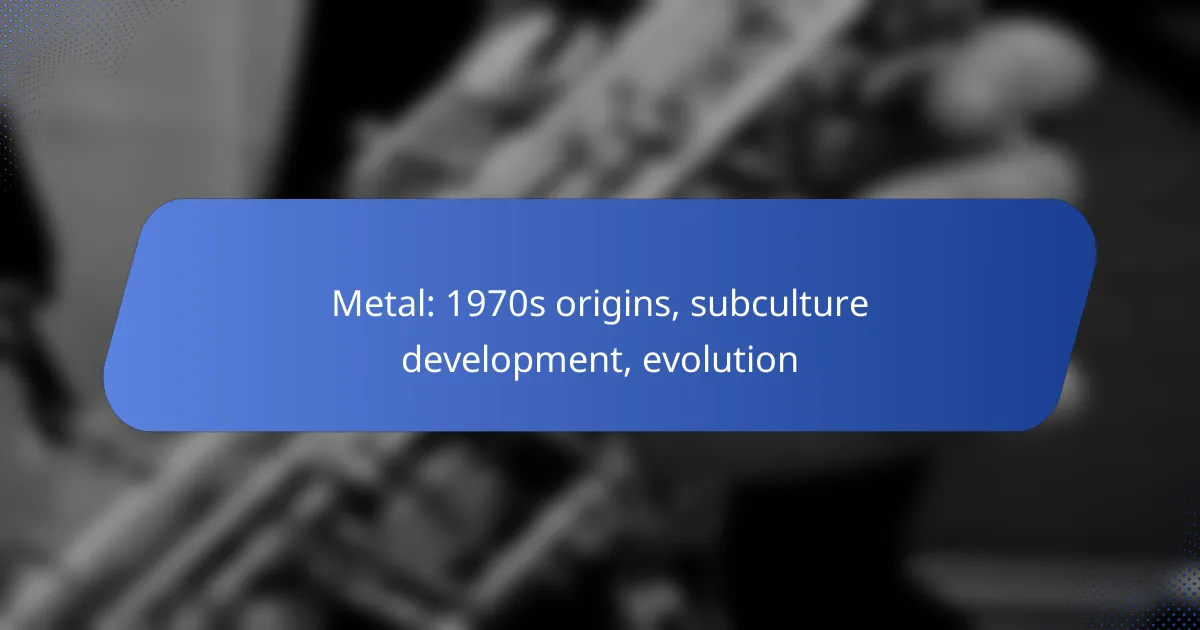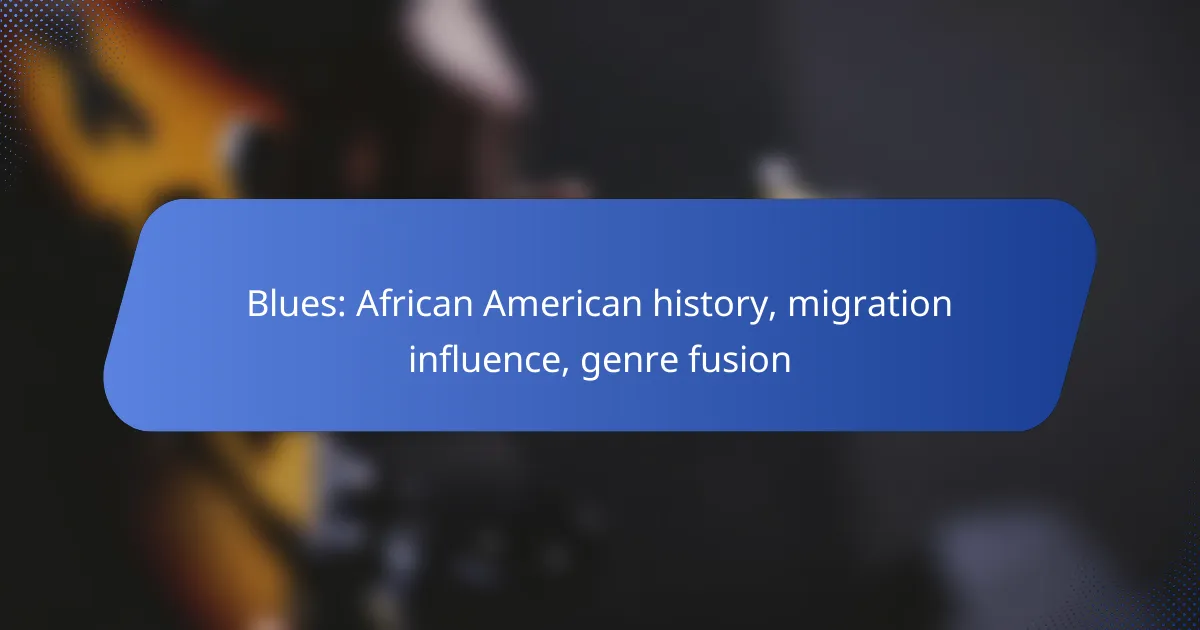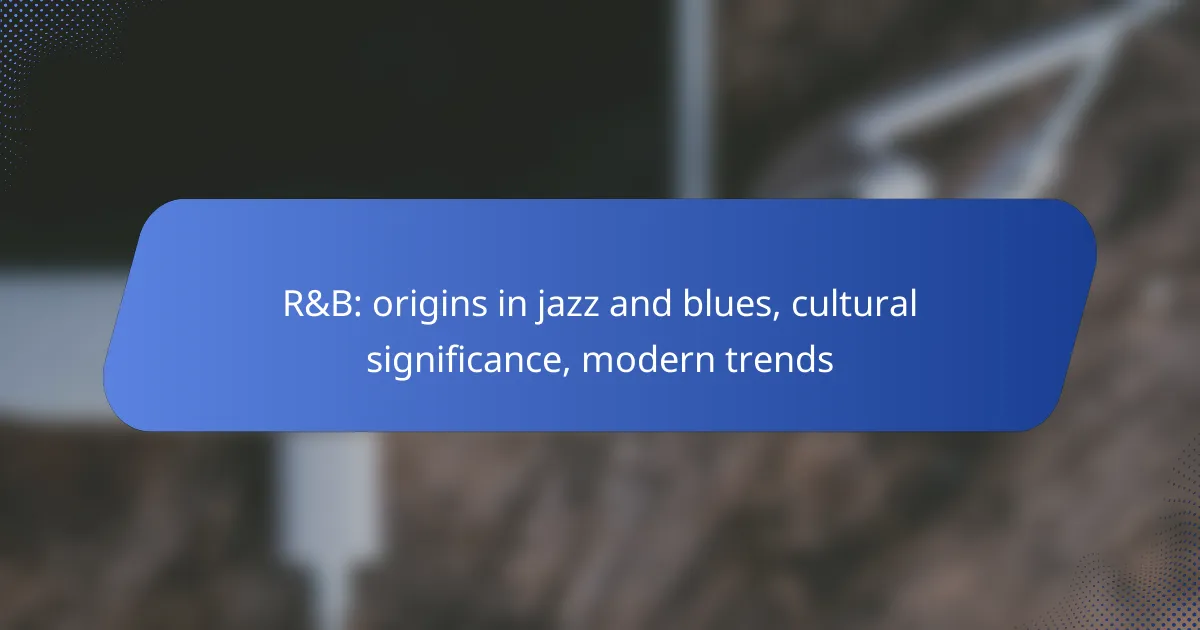Jazz originated in New Orleans, emerging from a rich tapestry of African, European, and Creole musical traditions in the late 19th and early 20th centuries. The Harlem Renaissance played a pivotal role in elevating jazz, providing a vibrant platform for African American musicians and integrating the genre into the broader American cultural landscape. Today, jazz continues to influence global music, showcasing its core elements while adapting to diverse cultural contexts around the world.

How did jazz originate in New Orleans?
Jazz originated in New Orleans as a unique blend of African, European, and Creole musical traditions. This vibrant city provided a rich cultural environment where diverse musical influences converged, leading to the birth of jazz in the late 19th and early 20th centuries.
Influence of African rhythms
African rhythms played a crucial role in shaping jazz music. The use of polyrhythms, syncopation, and call-and-response patterns, which are rooted in African musical traditions, became foundational elements of jazz. These rhythmic complexities contributed to the lively and improvisational nature of the genre.
In New Orleans, African American musicians incorporated these rhythms into their performances, creating a distinct sound that set jazz apart from other musical styles. The blending of African rhythms with European harmonic structures resulted in a dynamic musical form that resonated with audiences.
Role of Creole culture
Creole culture significantly influenced the development of jazz in New Orleans. Creole musicians, often of mixed African and European descent, brought their unique cultural perspectives and musical styles to the genre. This cultural fusion enriched jazz with diverse melodies, harmonies, and performance techniques.
The Creole community’s emphasis on music as a form of social expression helped to foster an environment where jazz could thrive. Their contributions included the incorporation of French and Spanish musical elements, which further diversified the sound of early jazz.
Development of brass bands
The development of brass bands was pivotal in the evolution of jazz music. These bands, often consisting of trumpets, trombones, and tubas, played at social events, parades, and funerals, making music an integral part of community life in New Orleans. The energetic performances of brass bands showcased improvisation and collective musicianship, hallmarks of jazz.
Brass bands served as a training ground for many jazz musicians, allowing them to hone their skills in a collaborative environment. This tradition of brass bands laid the groundwork for the later emergence of jazz ensembles and big bands.
Impact of Storyville
Storyville, the red-light district of New Orleans, had a significant impact on the development of jazz. Established in the late 19th century, Storyville was a hub for entertainment, where musicians could perform in clubs and bars. This vibrant nightlife attracted a diverse audience, fostering a lively music scene.
The exposure to various musical styles and the demand for live performances in Storyville allowed jazz to evolve rapidly. Many legendary musicians began their careers in this district, and the improvisational nature of jazz flourished in the intimate settings of Storyville’s venues.
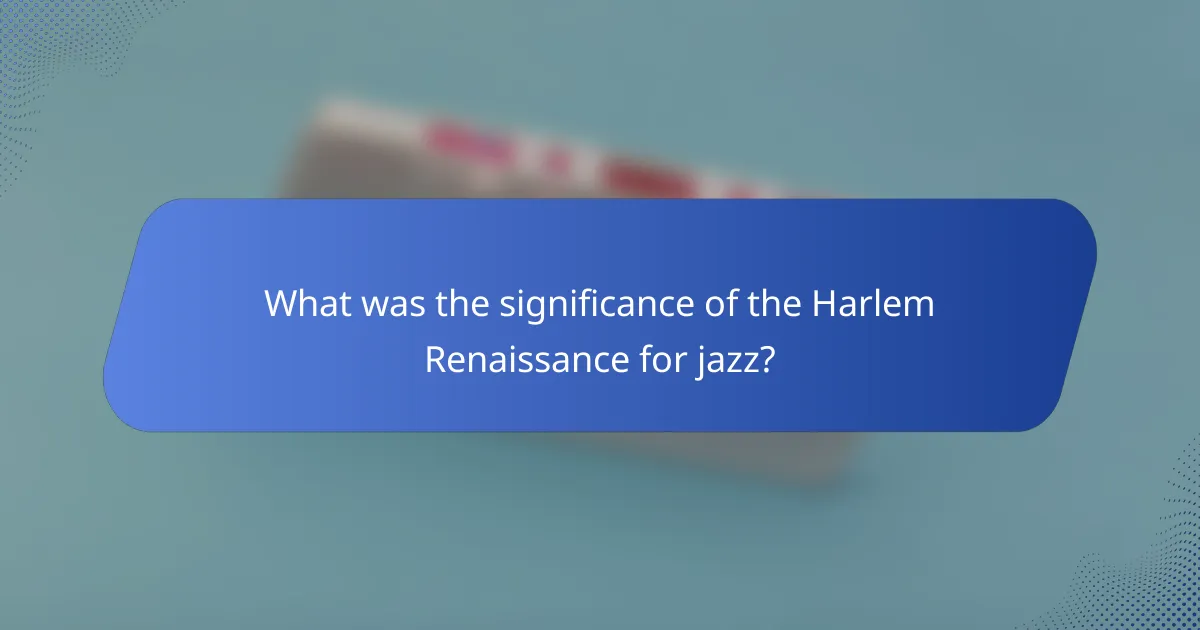
What was the significance of the Harlem Renaissance for jazz?
The Harlem Renaissance was crucial for jazz as it provided a vibrant platform for African American musicians, allowing the genre to flourish and gain national recognition. This cultural movement not only elevated jazz but also integrated it into the broader American cultural landscape, influencing various art forms.
Promotion of African American artists
The Harlem Renaissance actively promoted African American artists, creating opportunities for musicians to showcase their talents. Venues like the Cotton Club and the Apollo Theater became essential stages for jazz performers, helping to establish their careers and gain public acclaim.
Notable figures such as Louis Armstrong and Duke Ellington emerged during this time, benefiting from the increased visibility and support for black artists. Their contributions helped shape the sound of jazz and set the foundation for future generations.
Integration of jazz into mainstream culture
Jazz transitioned from a regional style to a mainstream phenomenon during the Harlem Renaissance, influencing popular music across the United States. The genre’s unique rhythms and improvisational style captivated diverse audiences, leading to its incorporation into various musical genres.
As jazz gained popularity, it began appearing in radio broadcasts, films, and dance halls, further embedding it into American culture. This integration helped to break down racial barriers, allowing jazz to be appreciated by a wider audience regardless of background.
Influence on literary and visual arts
The Harlem Renaissance’s impact extended beyond music, influencing literature and visual arts as well. Writers like Langston Hughes and Zora Neale Hurston drew inspiration from jazz, incorporating its themes and rhythms into their poetry and prose.
Visual artists, such as Aaron Douglas, used jazz as a motif in their work, capturing the energy and spirit of the music. This cross-pollination enriched the cultural landscape, making jazz a symbol of African American identity and creativity during this transformative era.
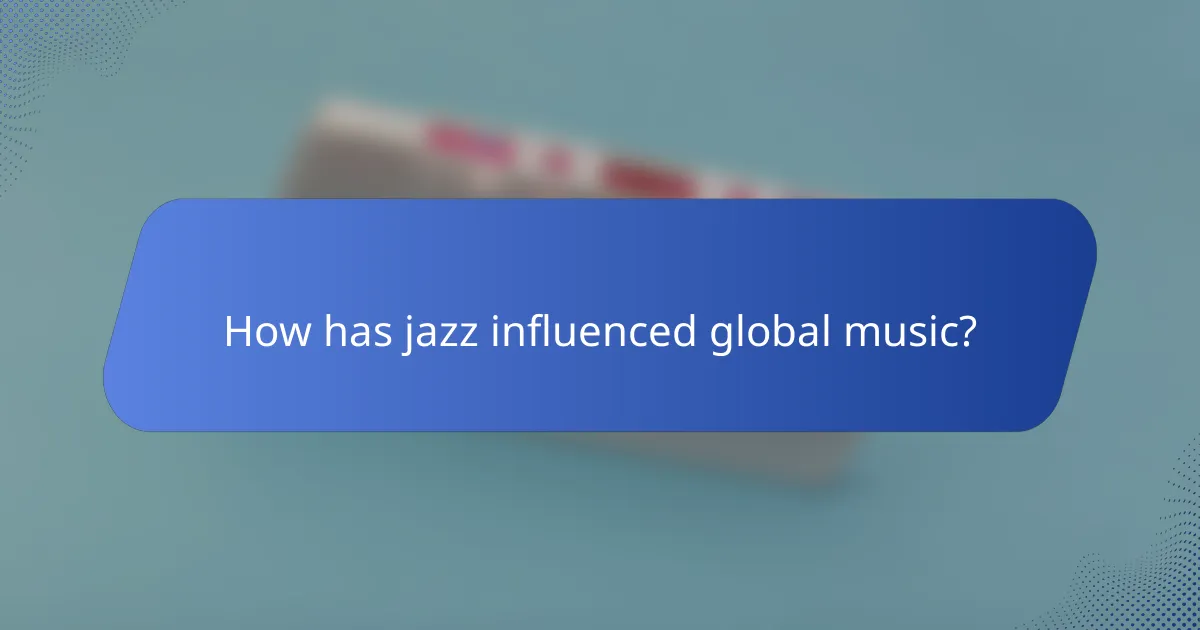
How has jazz influenced global music?
Jazz has significantly shaped global music by introducing improvisation, syncopation, and a rich blend of cultural influences. Its evolution has led to the creation of various genres worldwide, reflecting local traditions while maintaining the core elements of jazz.
Spread of jazz in Europe
Jazz made its way to Europe in the early 20th century, particularly after World War I, when American soldiers introduced it to local audiences. Cities like Paris and London became hubs for jazz musicians, leading to vibrant jazz scenes that attracted both local and expatriate artists.
European musicians began to adopt jazz elements, incorporating them into classical and folk music, which resulted in unique styles like gypsy jazz in France. Festivals and clubs across Europe continue to celebrate jazz, showcasing both traditional and contemporary interpretations.
Fusion with local music styles
Jazz has a history of fusing with local music styles, creating new genres that resonate with diverse audiences. In Brazil, for instance, bossa nova emerged by blending samba rhythms with jazz harmonies, resulting in a smooth, melodic sound that gained international popularity.
Similarly, in India, jazz has merged with traditional music forms, leading to innovative expressions that reflect the country’s rich musical heritage. This fusion often results in cross-cultural collaborations that enrich both jazz and local music traditions.
Impact on contemporary genres
The influence of jazz on contemporary genres is profound, as it has shaped rock, hip-hop, and electronic music. Elements like improvisation and complex chord progressions are now common in these genres, demonstrating jazz’s enduring legacy.
Artists across various genres often cite jazz as a major influence, leading to collaborations that blend styles and push creative boundaries. For example, hip-hop artists frequently sample jazz tracks, creating a dialogue between the two genres that continues to evolve.
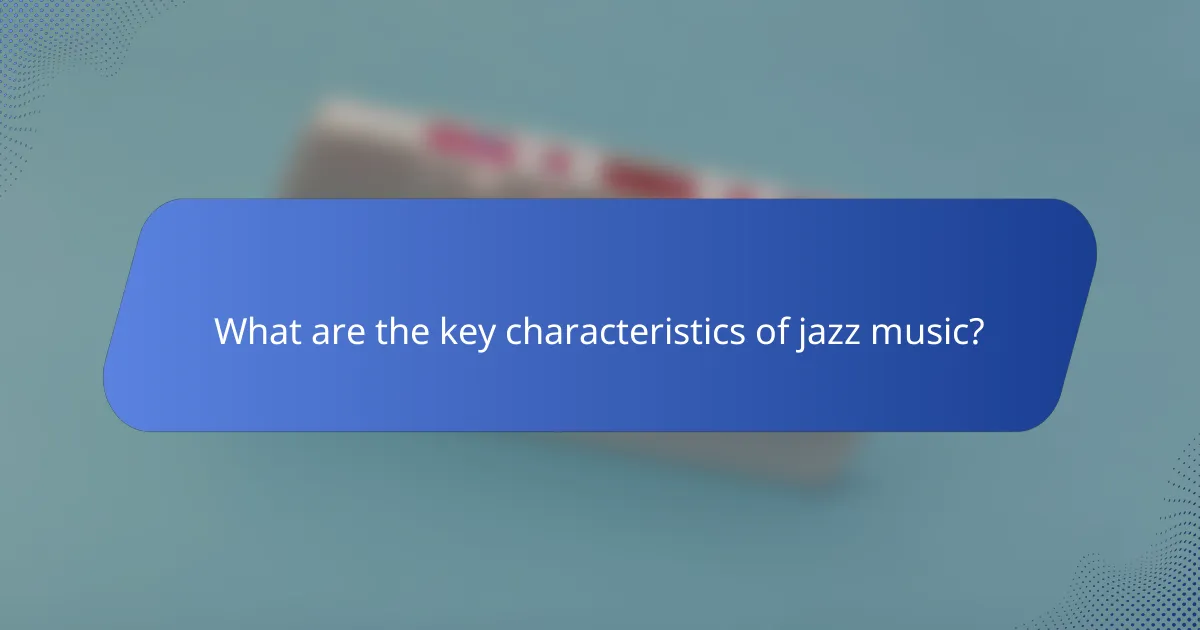
What are the key characteristics of jazz music?
Jazz music is characterized by its unique blend of improvisation, syncopation, and diverse instrumentation. These elements create a dynamic and expressive sound that has evolved from its roots in New Orleans to a global phenomenon.
Improvisation techniques
Improvisation is a fundamental aspect of jazz, allowing musicians to create spontaneous melodies and rhythms during performances. This technique often involves musicians responding to one another in real-time, fostering a conversational style that is central to jazz.
Common improvisation techniques include the use of scales, motifs, and call-and-response patterns. Musicians often practice improvisation by playing along with backing tracks or jamming with others, which helps develop their ability to think creatively and adapt quickly.
Use of syncopation
Syncopation is a rhythmic technique where emphasis is placed on off-beats or weaker beats, creating a sense of surprise and excitement in the music. This characteristic is essential in jazz, contributing to its lively and unpredictable nature.
Jazz musicians often use syncopation to enhance their solos and ensemble playing. By shifting the expected rhythmic patterns, they can create tension and release, making the music more engaging for listeners.
Instrumentation in jazz ensembles
Jazz ensembles typically feature a combination of instruments, including brass, woodwinds, strings, and percussion. Common instruments include the trumpet, saxophone, piano, double bass, and drums, each contributing to the overall sound and texture of the music.
The arrangement of instruments can vary widely, from small combos to large big bands. This diversity allows for a range of styles and sounds, enabling musicians to explore different genres within jazz, such as bebop, swing, and fusion.

How do jazz festivals contribute to cultural exchange?
Jazz festivals play a vital role in cultural exchange by bringing together diverse musical traditions and audiences from various backgrounds. They create a platform for artists to share their unique styles and stories, fostering mutual understanding and appreciation among different cultures.
Showcasing diverse artists
Jazz festivals feature a wide range of artists, representing various genres, cultures, and backgrounds. This diversity allows attendees to experience music from different parts of the world, such as Afro-Cuban jazz, Brazilian bossa nova, and traditional New Orleans jazz. By showcasing these artists, festivals promote cultural richness and highlight the global influence of jazz.
For example, a festival in New Orleans might include performances from local musicians alongside international acts, creating a vibrant tapestry of sound that reflects the genre’s roots and evolution. This exposure helps audiences appreciate the nuances of each style and its cultural significance.
Encouraging collaboration
Jazz festivals often facilitate collaboration between artists from different backgrounds, leading to innovative musical fusions. These collaborations can result in unique performances that blend various influences, showcasing the adaptability of jazz as a genre. Artists may participate in jam sessions or workshops, allowing them to learn from one another and create new works together.
Such collaborations not only enrich the festival experience but also inspire artists to explore new creative directions, further enhancing the cultural exchange that jazz festivals promote.
Promoting local economies
Jazz festivals contribute significantly to local economies by attracting tourists and generating revenue for businesses. Hotels, restaurants, and shops often see increased patronage during festival weekends, benefiting from the influx of visitors. This economic boost can be substantial, with some festivals drawing thousands of attendees.
Moreover, local artists gain exposure and opportunities to perform, which can lead to further engagements and income. Communities can leverage the popularity of jazz festivals to enhance their cultural identity and promote tourism, creating a sustainable cycle of economic growth and cultural exchange.
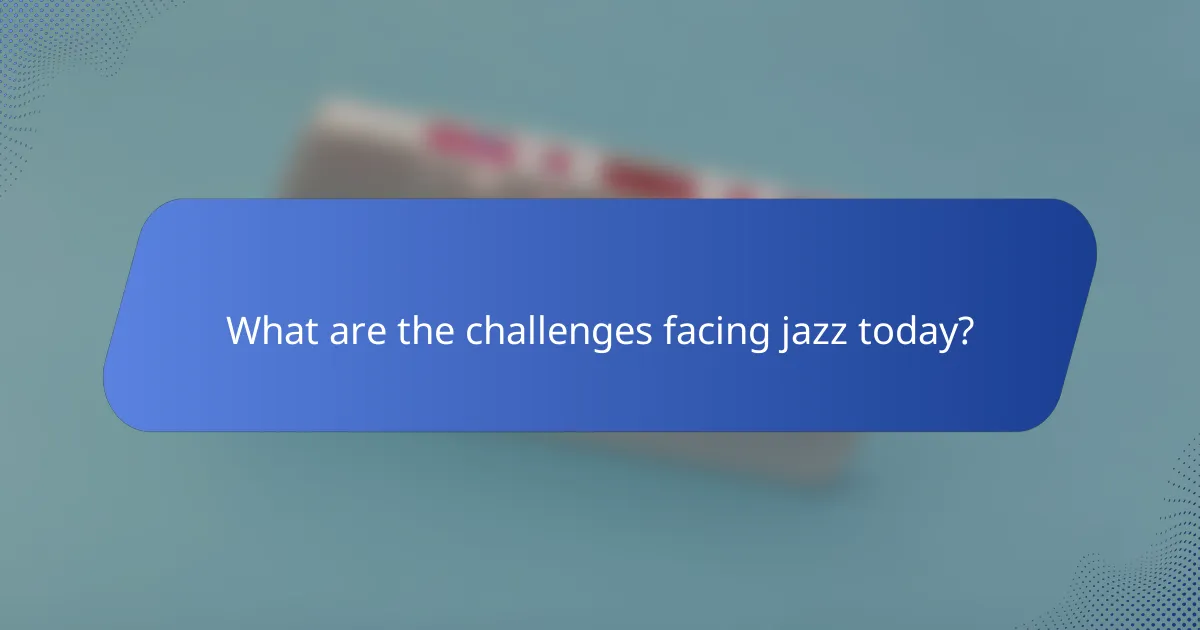
What are the challenges facing jazz today?
Jazz faces several challenges today, including declining audiences, competition from other music genres, and the struggle to maintain its cultural roots while evolving. These factors can hinder the genre’s growth and accessibility, impacting both artists and listeners.
Declining Audiences
One significant challenge for jazz is the shrinking audience base, particularly among younger generations. Many young people gravitate towards pop, hip-hop, and electronic music, which can overshadow jazz performances and recordings. This trend necessitates innovative approaches to attract new listeners.
Jazz musicians and venues are increasingly turning to social media and streaming platforms to reach wider audiences. Collaborations with artists from other genres can also help to introduce jazz to new fans, blending traditional elements with contemporary styles.
Competition from Other Genres
The music landscape is saturated with diverse genres, making it difficult for jazz to stand out. With the rise of digital music consumption, genres like pop and hip-hop dominate streaming charts, often sidelining jazz. This competition can lead to fewer performance opportunities and reduced funding for jazz programs.
To combat this, jazz artists can leverage cross-genre collaborations and fusion projects that appeal to a broader audience. Engaging with music festivals and events that celebrate various styles can also enhance visibility and relevance in the current music scene.
Maintaining Cultural Roots
Jazz originated from rich cultural traditions, particularly in New Orleans, and maintaining these roots while evolving is a delicate balance. Some purists argue that modern interpretations stray too far from traditional forms, risking the genre’s authenticity. This tension can create divides within the jazz community.
Artists can address this challenge by honoring jazz’s historical influences while incorporating contemporary elements. Educational initiatives that highlight jazz’s origins and its evolution can also foster appreciation and understanding among new audiences.
